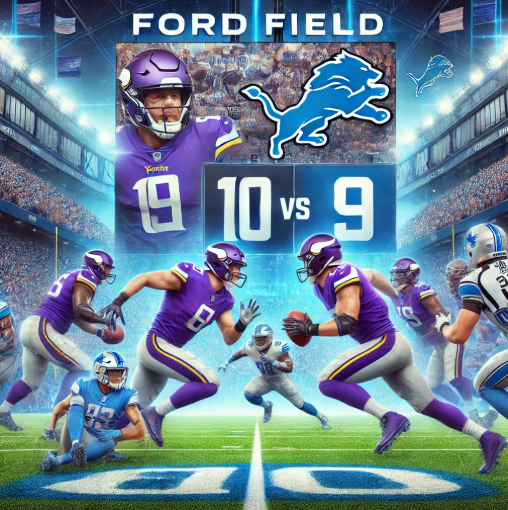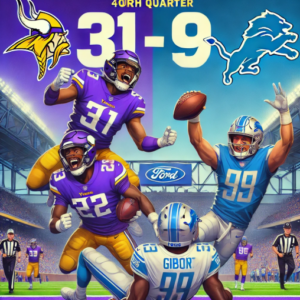Relive the thrilling Vikings vs. Lions game with a detailed third-quarter recap and fourth-quarter analysis, highlighting key plays, strategies, and playoff implications.
Vikings vs. Lions
In a high-stakes NFC North clash, the Minnesota Vikings and Detroit Lions met in Week 18, with playoff positioning and the division title on the line. Both teams entered with impressive 14-2 records, but only one could emerge as the NFC North champion and secure the top seed in the playoffs. The intense matchup at Ford Field showcased grit, strategy, and determination, particularly during the crucial third and fourth quarters.
This article provides an in-depth analysis of these quarters, exploring the strategies employed by both teams, the standout performances, and the game’s broader implications. Each section breaks down the key moments that shaped the outcome and examines how these moments will affect both teams heading into the postseason.
Third Quarter Recap: Key Plays
The third quarter began with the Lions leading 10-6. Looking to regain momentum, the Vikings initially made a strong defensive stand, forcing a quick three-and-out from the Lions. This defensive effort was crucial, as it demonstrated the Vikings’ intent to apply pressure and seize control of the game’s tempo.
Minnesota’s offense, under quarterback Sam Darnold, initiated a promising drive that featured short, precise passes to star receiver Justin Jefferson and tight end T.J. Hockenson. The drive showcased a balanced mix of run and pass plays, aiming to keep the Lions’ defense off-balance. However, the drive faltered in the red zone, and the Vikings had to settle for a 51-yard field goal by Will Reichard, bringing the score to 10-9 at 9:55 in the quarter.
Detroit’s response was methodical and efficient. Quarterback Jared Goff, known for his calm demeanor under pressure, led a 13-play, 70-yard drive that consumed over six minutes. The drive featured significant contributions from Jahmyr Gibbs, whose agility and vision were on full display. The Lions’ commitment to the run game paid off as Goff found Gibbs in the flat for a 10-yard touchdown pass, extending their lead to 17-9.
Minnesota’s next possession underscored their offensive struggles. Facing relentless pressure from the Lions’ defensive front, Darnold was sacked twice, leading to a quick punt. This inability to sustain drives and protect the quarterback became a persistent issue for the Vikings throughout the quarter.
Third Quarter Recap: Strategic Adjustments
Adjustments at halftime played a pivotal role in shaping the third quarter. The Vikings sought to exploit mismatches in the Lions’ secondary by utilizing their dynamic receiving duo, Jefferson and Hockenson. The strategy was to create quick, short-yardage gains to counter the Lions’ pass rush. Despite these intentions, execution issues and the Lions’ stout defense limited their effectiveness.
Detroit’s halftime adjustments focused on enhancing their offensive versatility. By incorporating more play-action passes and relying on their running game, the Lions managed to keep the Vikings’ defense guessing. This balanced offensive approach enabled Goff to find open receivers and sustain long drives, wearing down Minnesota’s defense.
Defensively, the Lions increased their blitz packages, aiming to rattle Darnold and force hurried throws. This aggressive tactic, combined with disciplined coverage by the secondary, effectively neutralized the Vikings’ offensive threats and kept the pressure on throughout the quarter.
Third Quarter Recap: Statistical Analysis
Statistically, the third quarter highlighted the Lions’ control over the game. They dominated time of possession, holding the ball for over nine minutes compared to Minnesota’s six. This dominance translated into sustained drives and increased scoring opportunities for Detroit.
Third-down efficiency was another critical metric. The Lions converted 60% of their third downs, maintaining their drives and keeping the Vikings’ defense on the field. In contrast, the Vikings struggled, converting only one out of three third-down attempts. This disparity illustrated the Lions’ superior execution and the Vikings’ offensive inefficiency.
A more detailed statistical breakdown is presented below:
| Category | Vikings | Lions |
|---|---|---|
| Time of Possession | 6:15 | 9:45 |
| Third-Down Conversions | 1/3 (33%) | 3/5 (60%) |
| Total Yards | 45 | 120 |
| Turnovers | 0 | 0 |
Fourth Quarter Preview: Initial Setups
The fourth quarter began with the Vikings trailing by eight points. Understanding the need for a quick turnaround, Minnesota’s strategy shifted towards a more aggressive passing game. The focus was on leveraging Jefferson’s ability to create separation and Hockenson’s size advantage to generate big plays and reduce the deficit quickly.
The Lions, on the other hand, were intent on managing the clock and preserving their lead. They opted for a conservative approach, emphasizing the running game to control time of possession. This strategy aimed to minimize mistakes and limit the Vikings’ scoring chances.
Fourth Quarter: Defensive Tactics
Minnesota’s defense, sensing the urgency of the situation, intensified its efforts to force turnovers. They employed various blitzes and disguised coverages to confuse Goff and create opportunities for interceptions. However, the Lions’ offensive line proved resilient, giving Goff enough time to make smart decisions and avoid critical mistakes.
Detroit’s defensive strategy focused on preventing the Vikings from making explosive plays. By keeping their safeties deep and maintaining tight coverage, they forced Minnesota into short, time-consuming completions. This strategy effectively burned precious time off the clock, aligning with their goal of securing a win through controlled game management.
Fourth Quarter: Offensive Strategies
The Vikings’ offensive adjustments centered on increasing their passing volume and pace. Darnold frequently targeted Jefferson and Hockenson, hoping to exploit any breakdowns in coverage. Despite these efforts, the Lions’ defense remained disciplined, consistently breaking up passes and limiting gains.
Conversely, the Lions relied heavily on their running backs, particularly Gibbs, to keep the chains moving and the clock running. This ground-and-pound approach not only maintained their lead but also physically wore down the Vikings’ defense, reducing their effectiveness as the quarter progressed.
Fourth Quarter: Crucial Moments
One of the most defining moments of the fourth quarter occurred during a critical fourth-and-goal situation for the Vikings. Opting to go for a touchdown instead of a field goal, Darnold’s pass to Jefferson was expertly deflected by Lions cornerback Cameron Sutton. This turnover on downs was a momentum-shifting play that effectively crushed the Vikings’ hopes of a comeback.
Following this defensive stand, the Lions embarked on a clock-consuming drive that ended with a field goal, pushing their lead to 20-9. The Vikings’ subsequent drives were marred by miscommunication and a missed field goal attempt, sealing their fate.
The Lions’ strategic dominance and execution under pressure were the deciding factors in their 31-9 victory over the Vikings. By securing the NFC North title and the No. 1 seed in the playoffs, the Lions solidified their status as serious Super Bowl contenders. The Vikings, despite their strong season, faced glaring weaknesses that need addressing as they head into the wildcard round.
FAQs
- What was the final score of the game?
- The Detroit Lions defeated the Minnesota Vikings with a final score of 31-9.
- Who were the standout players in the game?
- Jahmyr Gibbs (Lions) stood out with multiple touchdowns, while Jared Goff effectively managed the game.
- What were the playoff implications of this game?
- The Lions secured the NFC North title and the No. 1 seed in the NFC playoffs. The Vikings will enter the playoffs as a wildcard team.
- How did the Vikings’ offense perform?
- The Vikings’ offense struggled to find the end zone, settling for field goals and missing opportunities to score touchdowns.
- What records were set during the game?
- Jahmyr Gibbs set a new Lions single-season record with his 19th touchdown.
You can watch the full game recap on the official NFL website: https://www.nfl.com/live/.













